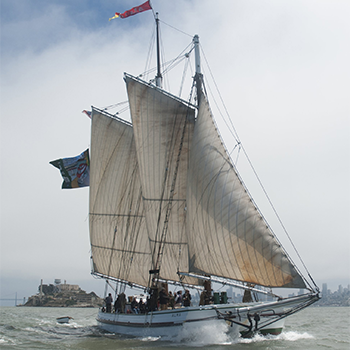
SignificanceSignificance statements express why San Francisco Maritime National Historical Park resources and values are important enough to merit national park unit designation. Statements of significance describe why an area is important within a global, national, regional, and systemwide context. These statements are linked to the purpose of the park unit, and are supported by data, research, and consensus. Significance statements describe the distinctive nature of the park and inform management decisions, focusing efforts on preserving and protecting the most important resources and values of the park unit.• San Francisco Maritime National Historical Park maintains the largest and most diverse collection of national historic landmark ships in the United States, representing a pivotal period of maritime commerce on the West Coast as the industry shifted from sail to mechanical power. • San Francisco Maritime National Historical Park’s collection, the oldest and largest maritime history collection in the western United States, provides tangible and compelling links to maritime history and heritage and is one of the largest museum collections in the national park system. • Located just inside the straits of the Golden Gate, San Francisco Maritime National Historical Park preserves and shares the area’s rich legacy as America’s first major West Coast seaport, a center for maritime commerce, and a gateway for immigration and migration. • San Francisco Maritime National Historical Park is the premier West Coast showcase for traditional and contemporary maritime skills, perpetuated through hands-on preservation, research and education, and the continued operation of historic ships and equipment. • The Aquatic Park National Historic Landmark setting, including the maritimethemed architectural design and art of the Aquatic Bathhouse Building, offers easy access to an oasis of recreation and beauty in a highly urbanized area on the San Francisco Bay waterfront. Fundamental Resources and ValuesFundamental resources and values are those features, systems, processes, experiences, stories, scenes, sounds, smells, or other attributes determined to merit primary consideration during planning and management processes because they are essential to achieving the purpose of the park and maintaining its significance.• Historic Fleet of Ships • Maritime Skills • Waterfront Recreational and Scenic Opportunities • Aquatic Park Bathhouse (Sala Burton Building) • A Center for Maritime Research • Opportunities to Understand Maritime Heritage • Opportunities to Experience Vessels on the Water • Collections San Francisco Maritime National Historical Park contains other resources and values that may not be fundamental to the purpose and significance of the park, but are important to consider in management and planning decisions. These are referred to as other important resources and values. • Other Historic Structures and Vessels • Haslett Warehouse Interpretive ThemesInterpretive themes are often described as the key stories or concepts that visitors should understand after visiting a park—they define the most important ideas or concepts communicated to visitors about a park unit. Themes are derived from—and should reflect—park purpose, significance, resources, and values. The set of interpretive themes is complete when it provides the structure necessary for park staff to develop opportunities for visitors to explore and relate to all of the park significances and fundamental resources and values.• Maritime Commerce: Economic – Pacific coast maritime history illustrates the vital role maritime communities played in expanding trade, bridging local and global economies, and building maritime industries that continue to fuel national development. • Maritime Commerce: Social – The development of San Francisco and the surrounding region demonstrates how maritime trade and transportation created a social crossroads that both fostered the interchange of cultures and ideas and led to exploitation and conflict. • Ship to Shore – The unique nature of life on the water has created a distinct maritime culture with unique social structures, rich traditions, and specialized skills that influenced the sphere of life and arts ashore. • Technology and Change – Maritime technology developed in tension between tradition and innovation. Changes in maritime technology had profound impacts on individuals, industry, and society as a whole. • The Maritime Environment – West Coast maritime history reveals the complex interactions between humans and the maritime environment. This insight helps us contemplate our environmental responsibility and highlights our physical, emotional, and spiritual connections to the water. 
DescriptionSan Francisco Maritime National Historical Park is in San Francisco, California, just inside of the Golden Gate. Congress established the Park in 1988 to preserve and interpret the history and achievements of seafaring Americans and the nation’s maritime heritage, especially on the Pacific coast. The 50-acre park uses a fleet of national historic landmark (NHL) vessels, a collection of more than 100 historic small craft, a museum collection with more than 6 million archival and museum items, a visitor center, and a research center to chronicle the lives and dreams of the men and women who tamed America’s maritime frontier. The San Francisco Bay has long played an important role in maritime history. Native peoples plied San Francisco Bay in reed canoes long before explorers first charted America’s western coastline and the Spanish established an outpost at the site of present-day San Francisco. After gold was discovered in 1848, the sea brought waves of dreamers to California. They entered the Golden Gate aboard anything that could float and then raced to find their fortunes. Ships brought goods to the west and took rich western resources to the world. The first stop for many visitors is Hyde Street Pier, which features a number of historic vessels, maritime structures, and exhibits. Here visitors can visit the NHL ships Alma, Balclutha, C.A. Thayer, Eureka, and Hercules and watch maritime skills in action in the Shipwright and Boat Shops. The park’s visitor center, across from Hyde Street Pier, provides a multimedia orientation to West Coast and San Francisco maritime history. The pathways of the Aquatic Park National Historic Landmark District lead to the Maritime Museum, a striking, Streamline Moderne building and filled with 1930s Works Progress Administration artwork. Outside the bathhouse, the Aquatic Park cove and beach are protected by the curved Municipal Recreational Pier. The park’s extensive collection of artifacts, books, oral histories, photographs, vessel plans, documents, and other archival materials are located at the Maritime Research Center. Each year, in partnership with the San Francisco Maritime National Park Association, the park hosts more than 10,000 local schoolchildren in hands-on, experiential education programs. The park also nurtures relationships with community groups and neighbors for a variety of other programs and special events.
|
Last updated: November 17, 2017
